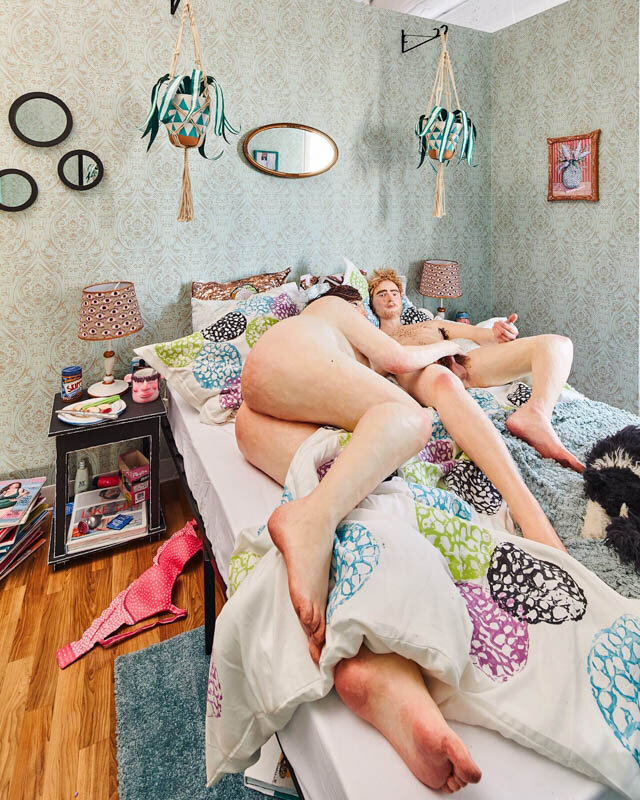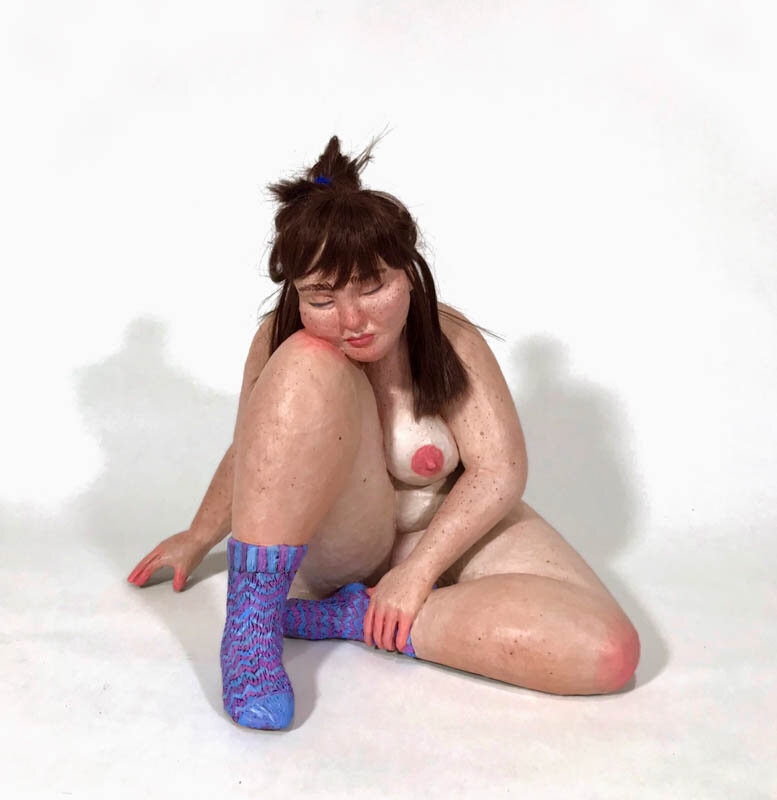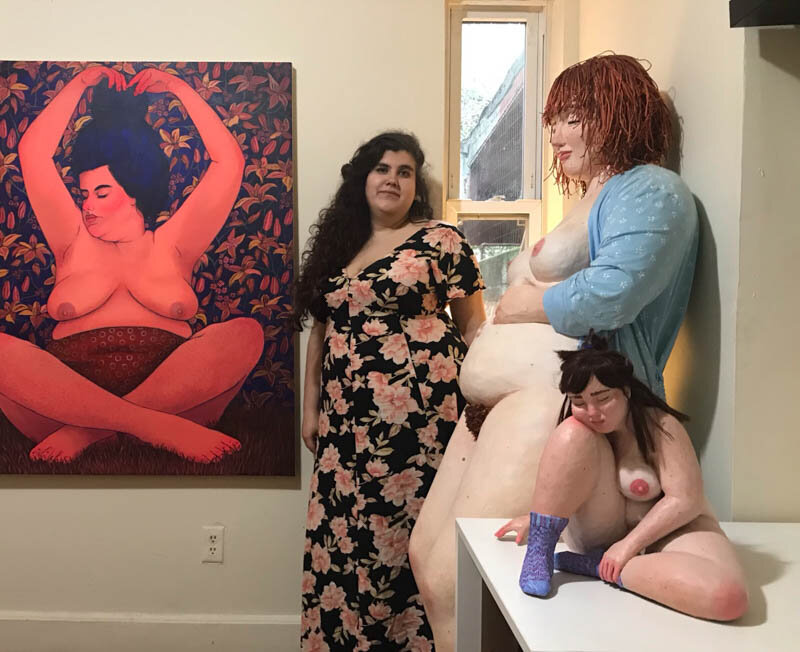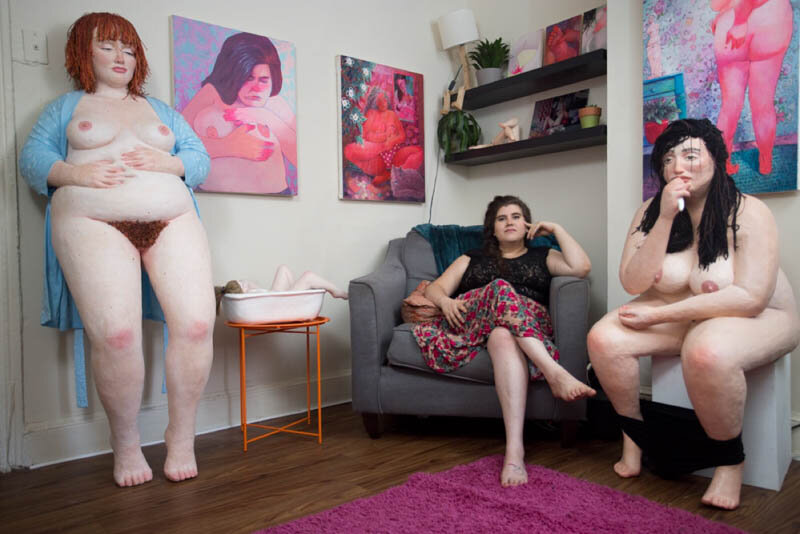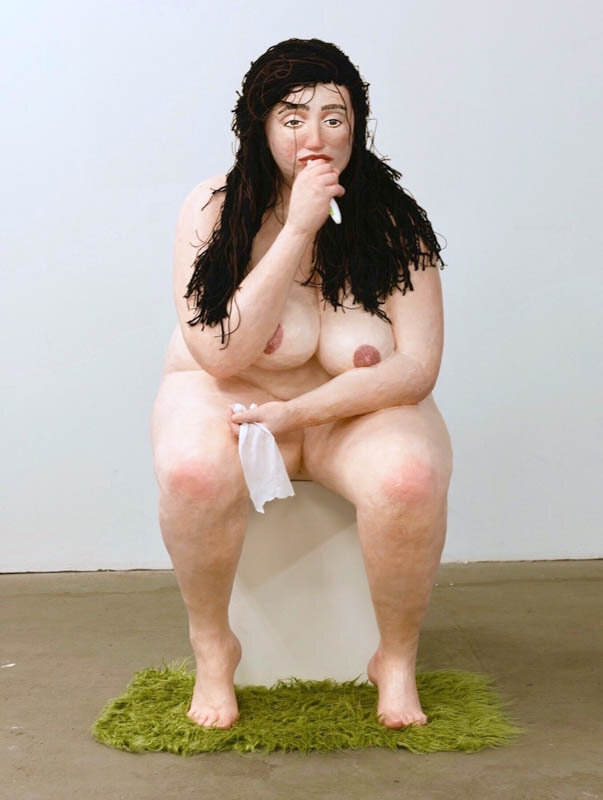Shona McAndrew
Born and raised in Paris, France, Shona McAndrew moved to the US to get her Bachelors degree in Psychology and Fine Arts at Brandeis University. She furthered her studies with a Masters in Fine Arts at the Rhode Island School of Design. McAndrew has exhibited her work across the US (New York City, Boston, Philadelphia and Providence, LA). Both Shona and her work have been featured in the Huffington Post, CNN, ID Magazine, Bustle, Vice, Playboy, Whitehot Magazine and many more. She lives and works in Philadelphia, PA.
Statement
Shona McAndrew's painted papier-mâché sculptures, installation, digital collages and paintings depict women in quiet private moments. Often life-size or slightly larger, her sculptures draw from personal experience and observation to call attention to the simultaneous banality and importance of fleeting, introspective, honest and vulnerable moments. Informed by her experiences as a plus size woman, of body-dysmorphia and struggles with societal expectations of womanhood, McAndrew imagines these figures as friends, allies and self portraits in states of reveal in an unbroken stream of daydreams. Unembarrassed by their often exposed bodies and seemingly unaware and unconcerned about the viewer's careless voyeurism, Shona’s women ask us to valorize activities of body exploration, self care and forgetting to see one self through the critical eyes of others.
Interview with Shona McAndrew
Questions by Emily Burns
Hi Shona. What are some of your early memories of art or art-making from your childhood growing up in Paris?
I consider art the only tradition my family had throughout my childhood. My parents never married, come from different countries and don’t have the same culture or religion. But both of them love music and the arts. One of my most prominent memories is a watercolor drawing I did of an old couple siting by a pond in the Tuileries Gardens. I must have been no older than 5 or 6, and the drawing could not have made my mother prouder. She made pillows with the image printed on it, so I grew up looking at them every day. My mom has always been my biggest fan.
Are there any other makers in your family? Can you talk about your decision to pursue a career as an artist?
There are, I come from a long line of women artists. All of us share the same love for art making. In four generations, we have done a lot, from painting and sculpting to weaving and performance art. We all have had a similar focus on the figure. As for deciding to pursue a career as an artist, it all happened very naturally. I started off wanting to be a psychologist in Undergrad. After graduation, I took a year off to pursue art in a post-bac program. One year became two. Then I applied to grad school to see if I could get in anywhere. Long story short, here I am.
You’re currently based in Philadelphia, but have lived in various cities over the years. How has working in these communities shaped your creative practice? Can you tell us about your current studio? What is a typical day like for you?
The most honest answer is no matter where I am, I am able to sustain a very similar practice. The past 3 years I have had a studio in my home and I absolutely love it. It perfectly fits my needs. Especially when I am in a production crunch, I will stay up late and enjoy losing myself to my practice. Because I can just walk downstairs and start making, I find it much easier to stay motivated, working the long days needed to finish ambitious projects. It can be a sacrifice at times, but I have never felt limited by where I am or what I have around me. Perhaps it is naive, but I truly believe anything can be made if you try hard enough. And to be honest, it has worked out so far. First I have an idea, then I figure out how and where to make it. My installation at Spring/Break 2019 was made in the small guest bedroom in my current home, a room smaller than the booth itself. When I got the offer for my solo show at Chart, I donated or threw out all of my living room furniture and expanded my studio to yet another room in my house. I love to indulge my practice and ideas.
When were you initially drawn to working with paper-maché? What prompted this decision?
The summer before my MFA at RISD, I went home to Paris for the summer. Building anxiety while losing patience, I needed to make sure I could take it back to the US with me by plane, so it had to be small and compact. I happen to have just seen a paper mache tutorial on Youtube of a delightful old lady making a french bulldog. She made it seem to simple, and absolutely within my abilities (I had never made a sculpture before). So I made my first little lady, her name is Sophie and she’s tiny and adorable.
I brought her with me to the states and had her lying around my studio at RISD. I didn’t see her as art piece, but just this funny little thing I made that reminded me of home. Funnily enough, people kept walking past my paintings straight to that little sculpture. I started to understand that there was more to her than just a random experiment to pass an anxious moment. The curiosity and excitement surrounding her became contagious and definitely led to my current sculptures.
Most often your work captures female figures engaged in mundane activities or intimate moments. In what ways do you address issues surrounding identity and gender through your work?
It occurred to me that most of the first plus-size bodies I encountered were sad “before” pictures about to be transformed into their thin, happy “afters”. No acknowledgment of who they were in the moment, just “flawed” bodies on their way to a better self. Imagery along those lines truly made me feel that as an overweight woman, I could never be a complete person. Just a failed version of whoever I was meant to be. And, I’m sure many different kinds of people can empathize with this, it is not easy to invest or believe in yourself if you think you are already a lost cause. It wasn’t until I saw people who looked like me exist fully, with no shame or filter, that I was able to see myself as a worthwhile whole person. Focusing on mundane and intimate moments in my work allows me to highlight moments where women are simply living for themselves. I want to show women mid-thought or daydream, unburdened by external societal pressures where she doesn’t care about who she was yesterday or who she’ll be tomorrow. It’s about the woman, in her space, existing only for herself.
Can you talk about the ideas informing the scale of your sculptures, as well as the potential impact this has on the viewer’s experience?
The life-size sculptures have a true presence in a room. I’m constantly told by curators or people who spend a lot of alone time with my work, that my sculptures feel like there’s another person in the room with them. I like that the larger sculptures have a lot of secret moments and things to discover. Viewers tend to crouch low, walk around them and inspect closely. The smaller sculptures can feel more intimate. For me, they evoke a much more maternal instinct. The smaller work feels more precious and delicate, more reminiscent of a child with their favorite doll.
Earlier this year Sometime Last Night was included in SPRING/BREAK Art Show. Do large-scale installations, such as this recreation of your bedroom, involve detailed planning or would you describe it as a more intuitive process?
I love overwhelming projects like that installation. At the risk of giving an unsatisfying answer, it is a bit of both. At the start, I have something like a fuzzy vision of what I hope to make. So you make some plans off of that, but inevitably as you work, you make discoveries or have ideas that leads the work in exciting new directions. Once my idea is locked in, I make an abstract list with hundreds and hundreds of things to check off. Weld armatures, apply paper mache, paint skin, sculpt toes, glue leg hair, sow pillows, varnish butt plug, curl leaves, sand nail polish bottles, etc. The lists feels never ending, but I just take it one at a time. Having such a multifaceted project, I can also jump around a lot and stay engaged. Nothing is more satisfying than checking off the last thing on that once impossibly long list. So my answer is that my practice is at times very planned, and at times incredibly intuitive. I am working to find the perfect balance between the two.
In addition to your well-known sculptures, you also create digital collages and vibrant acrylic paintings. What are the relationships between these different ways of working?
My practice feels very organic. Whatever it needs, I do it. If it has to exist in the round, then I’ll sculpt it. If the concept dictates that the work needs to be a painting, then I am happy to pick up my brushes. My collages act as a sort of bouncing off point for most of my ideas. In a way they act like drawings, as a quick, no risk step that helps me picture the world I am about to create. If it weren’t for my digital collages, I wouldn’t have developed the confidence to trust my intuition.
The recent exhibition MUSE at Chart Gallery marked your first solo show in New York and featured all new work—9 paintings and 5 sculptures. What was your approach to preparing for this exhibition?
It all started with a dozen or so digital collages. I’m a creature of habit and once I get started on something, I enjoy diving deep into it. So once I make one digital collage, it can easily snowball into a dozen in a matter of days, solely out of the excitement of generating and progressing through so many ideas. I picked my favorites and began reaching out to women who I wanted to paint. I was lucky that every woman wanted to be a part of the project. To be honest, from the moment Maria Brito (the curator) came to me with the idea of a show, everything fell into place perfectly. I never really had a glitch or an issue. I did have less than 5 months to create the whole body of work, so maybe I just didn’t have time to second guess myself.
Can you talk about the influence of historical paintings on this body of work?
A lot of art history can be viewed as the porn of history. Rich men would commission male artists to make paintings objectifying women for the desire and pleasure of men. I want my work to function in antithesis to this male gaze that dominates art history, advertising and media. Historical paintings act as a starting point for me to re-envision these poses, where women are not motivated by male desire but by their own complex inner worlds. For my solo show at Chart, I focused on harem paintings because women in those paintings truly had no agency. They existed in a space centered around the practice of waiting for men. I wanted to take these poses and place women in a space where they were unapologetically waiting for no one.
For the paintings in this exhibition you sent “nudes” of yourself to other women, your muses, and asked them to send back their own versions of these images. Can you share more about these interactions and what motivated this decision?
The decision to reach out to people stemmed from my desire to expand my practice outside myself. I had been working with a lot of self-portraiture, and wanted to celebrate different shapes, colors and sizes of bodies other than my own. As for the interactions, they were all extremely positive. All the women I have worked with have been extremely generous and vulnerable with me and I definitely feel the pressure to do them justice.
How do you feel your body of work has developed over time and how do you anticipate it progressing in the future?
I hope that I am able to continue indulging my ideas in the same way I have these past couple years. I always want to do bigger and better than my last project, so who knows where my practice goes. I know that I hate to settle and that I get restless quickly, which I think will allow me to have a very expansive and experimental practice.
Who are some contemporary artists you feel your work is in conversation with?
There are so many! Allison Zuckerman and I both appropriate and recycle art historical paintings, especially made by men. We both want to rewrite similar stories. I hope to one day be in conversation with Robin Francesca Williams and her incredibly bravery and curiosity with paint. Jenna Gribbon is another. The list goes on and on.
How do you feel social media has impacted the general experience of looking at or exhibiting art? Can you talk more specifically about your experience with sharing images of your own work?
Social media certainly has its pros and cons. Obviously, given my subject matter I have had my fair share of struggles with censorship that disproportionately affects posts from individuals with non-typical, othered bodies. On the other hand, every single emerging artist has received some significant opportunity through Instagram. My installation at Spring/Break was a direct response to an art world mediated so heavily by social media. The installation needed to be experienced in person, but also rewarded the viewer for doing so. There were so many little moments to discover, allowing each viewer to curate their own pictures and memories. That type of energy also seemed to happen in my solo show at Chart. Each person had their favorite painting, favorite patterns and favorite details that they react to the strongest.
What have you been reading, watching, or listening to lately?
Lizzo! My days are long at the studio and I like to have something playing in the background. But my favorite thing I have seen in the past few years is Nannette by Hannah Gadbsy. I hope everyone watches it, if they haven’t already. Her stand-up special really exposed me to how I was using self-deprecation as a sort of painful self-defense mechanism. In the art world, so often work comes from a place of critique. But after hearing Nannette, I wanted my work, first and foremost, to be celebrations of women. Celebrations of the many beautiful and unique ways we express being humans. And more specifically, the many ways women exist in this world.
What’s next for you? Do you have any upcoming exhibitions, events, or other news you’d like to share?
I have a couple group shows coming up, which I’m quite excited about. I have a solo show of my life-size sculptures at the Moore College of Arts and Design opening late January. I also have a big project in the making, but it’s still too early to talk about. If things work out, I definitively see it becoming the most ambitious piece of mine to date.
To find out more about Shona and her work, check out her website.


